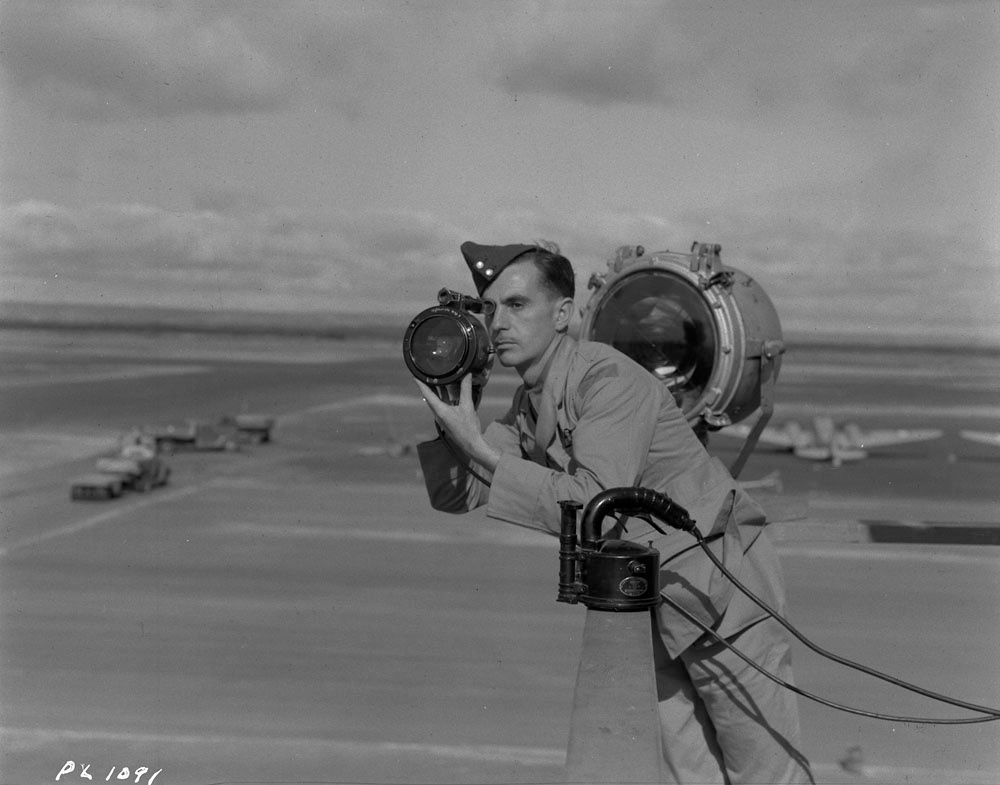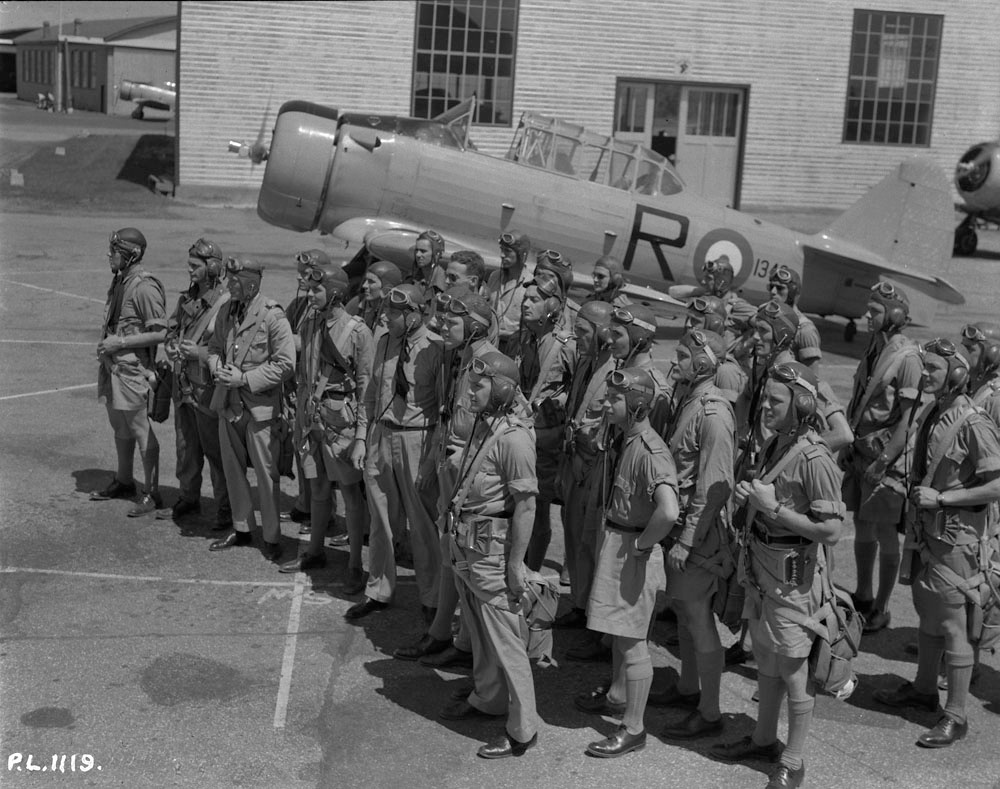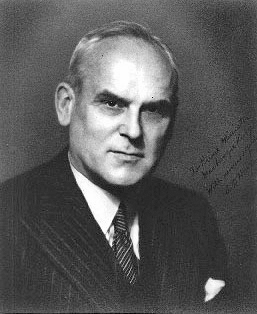
(Two Canadian airmen undergoing their initial training in Toronto. Practicing on another member of their course while equipped with chemical warfare gear.)
By July of 1940, the BCATP was really starting to get going in Canada. For those of you who are unaware, the BCATP (British Commonwealth Air Training Plan) was a scheme devised between England and its Commonwealth in the first weeks of the war. The Canadian government responded enthusiastically to the proposal, it being a large, visible contribution that would cost little in terms of lives (air accidents were less deadly than combat). The idea was rather straightforward; establish training schools for pilots, navigators, wireless operators, gunners, bombardiers, flight engineers, and maintainer positions in the Dominion nations, far from the enemy.
The Canadians had several factors that put them in a better position to support the plan and it was agreed that the majority of training would occur there. First of all, Canada was closer to England itself than most of the other Dominions, but doubled its value with equal access to the Pacific theatre as well. The weather was generally favourable most of the time, and the massive size of the country allowed for long range navigation and endurance training for navigators and pilots. Whilst relatively small, Canada at least had some industrial capacity when it came to building aircraft, or at least more than the other Dominions. The United states was right next door, providing spares and equipment that Canada could not produce locally or have sent from England. There were ample natural resources for the production and maintenance of a training program, with Canada providing her own oil supply. The Germans, and later the Japanese, were much too far away to present any danger.
The final agreement, signed by Canada, the United Kingdom, Australia, and New Zealand on the 17 of December 1939, listed the percentage of trainees each country would send, the percentage of costs each would take on, the training schedule, and the aerodrome opening schedule. To accommodate its shortage of foreign currency, the United Kingdom paid its portion by supplying and transporting necessary materials that Canada could not provide, such as aircraft, spare parts, airframes, and engines. The estimated total cost was $660 million dollars.
The plan (as it was set in Canada) would require its first schools to open by May of 1940, and the entire operation was aiming to produce 20,000 aircrew a year by 1942. Administration, repairs, equipment, and the training of instructors would occupy schools and depots to a total of 74, and that wasn’t counting administrative/command facilities. Some 3500 training aircraft had to be procured, along with 6500 engines and an ample supply of spare parts. Canadian public reaction to all of it was somewhat mixed. Many felt that supporting both the Air Training Plan, and the expanding Canadian military would not be financially or industrially feasible. Furthermore, where was the government going to find 40,000 Canadians to staff the program when the Army and Navy were undergoing their own expansions? Canadian money was better spent funding Infantry divisions, not training aircrew from the safety of home.
The RCAF itself had two well equipped training schools, one at Camp Borden, and one in Trenton, both in Ontario. Most of the other RCAF stations were not nearly as well equipped.

(Leading Aircraftman C.F.K Mews, sending a message with an Aldis lamp, July 30th, 1940.)

(Student pilots observe aircraft maneuvers before beginning their Initial flight training. Camp Borden, July 30th, 1940.)
Canada’s 17 civilian flying clubs agreed to shoulder the burden of elementary flight training. Commercial operators flying bush routes and charter flights agreed to run schools where observers could be trained by RCAF men. From the air force reserves came many administrators and basic instructors. These men, led by the permanent members of the RCAF, were to be the foundation on which the flying schools were built.
The implementation of the plan and the success of its early stages can be directly attributed to three men.
Air Minister Power’s department recruited flying trainees by the thousands, raised the necessary ground personnel, and trained young fliers from across the Commonwealth (and a few Americans who skipped over the border to join up).
C.D. Howes Department of Transport organized the construction of the aerodromes and found the aircraft required. First as minister of transport and the cabinet member responsible for the War Supply Board, then as minister of munitions and supply, Howe worked miracles.
The third man was Ralph P. Bell who, after joining Howe’s executive committee, directed the aircraft program. A group in Howes Department of Transport, working under J. A. Wilson, director of civil aviation, found the airfield sites. A number of satisfactory coastal fields were excluded because they were in defense areas. Mountainous terrain ruled out most of British Columbia. The prairies were ideal, as were the more lightly populated areas of Ontario, Quebec, and the Maritimes. By the time the four governments had worked out their agreement, Wilson’s engineers had chosen most of the sites, using the Canadian National Railways real estate department as its negotiator.
Things in Ottawa were very confused. Contractors waited expectantly for instructions to build airfields near remote prairie villages. Lined up in the same government buildings were representatives of firms seeking contracts to build airplanes. Men borrowed from private firms initialed purchase orders demanding immediate delivery of everything from jeeps to jigsaws. In other offices sat salt expediters whose job was to make sure that these supplies arrived on time. Behind them all, working a minimum 14-hour shift, was Clarence Decatur Howe, a man of action who had the power to enforce his decisions. In all of this confusion, the plan began to take shape. The first instructor’s course started at Camp Borden. Buildings arose on a score of new airfields. Then, just as the first 169 pilot trainees mustered at Toronto, the Germans initiated their invasion of France and the Benelux countries.
The repercussions were immediate. Britain quickly relayed that they could no longer fulfill their promise to send over 1500 of the twin-engine Avro Anson, which was the primary trainer for bomber crews and larger aircraft. A shipload of Ansons that were already en-route on a west-bound convoy were promptly returned to the UK. Air Minister Power recalls in his written account that “this sent Ottawa into a bit of a panic, and there were fears the entire scheme would be abandoned. The English were quick to assuage our fears, and insisted that training continue and that work on expanding the plan continue on as before.”
The Air Ministry turned its eyes to the United States, with an eye to acquiring 600 single-engine T-6 Texans (renamed the Harvard in Commonwealth service), and they were subsequently delivered. The Harvard in its yellow training colours would become the symbol the BCATP. With Britain requiring every aircraft, engine, and spare part for her own defence, Canada took over many aspects of the plan which were to be run by the British. It was up to Howe to telescope two years of the air training plan into one, not to mention find more aircraft and engines to replace all the ones that would not be coming from Britain. Money was no longer an issue. Howe himself had a pretty full schedule already. He was building merchant ships, ordering small arms, setting up munitions production, attending dozens of events that required his personal attendance, making speeches across the nation, nationalizing factories that were underperforming or we refusing to work with the government (Unpatriotic was the term that was used). All of this lay atop his promise to Air Minister Power to get the training schools up and running on time.

(Clarence Decatur Howe essentially controlled almost all of Canada’s wartime production, removing owners and executives he viewed as incompetent and replacing them with his own people. He establish 28 “Crown Corporations” which were government industries that worked on everything from secret projects to everyday war materials. I recommend you give his wikipedia page a once over if you are further interested. To make a long story short, he essentially initiated an industrial revolution in Canada so subtle and widespread that most Canadians didn’t realise it was happening, and by 1943 Canada was the 4th largest producer of war goods, vehicles and aircraft, trailing only the US, the Soviets, and the UK.)
Aircraft for basic flying training purposes were already plentiful, with the venerable Tiger Moth biplane operating out of formerly private clubs across the country, along with a few other “elementaries” which had been scrounged up. What was required were advanced twin-engine aircraft that could train navigators, observers, flight engineers, and wireless operators. Recruits were being drilled, taught military procedure, given 8 weeks of basic flying training, and then piling up waiting for advanced training. Ansons from the UK were no longer coming across the ocean. A small number were already in Canada, and they were flying everyday to handle the constant influx of recruits. Howe decided that Ansons would have to produced locally in order to satisfy demand. The fuselages would be built locally, with plywood replacing steel (sometimes, it varied throughout the war) and 5000 Jacobs L-6MB R-915 engines from the United States replacing the Armstrong Siddeley Cheetahs as the powerplant. Canadian Mk IIs also replaced the manual landing gear retraction system of the Mk I with a hydraulic one.
One of Howes crown companies was formed to produce these new Ansons; Federal Aircraft. Its first objective was to redesign the Anson to take the Jacobs engine and then to farm out contracts. In addition, Federal was to turn out the first mock-ups and flight test them.

(Four aircraftmen pose beisde a Tiger Moth at Elementary Flight Training School No. 8, Vancouver, BC. September 27th, 1940)
